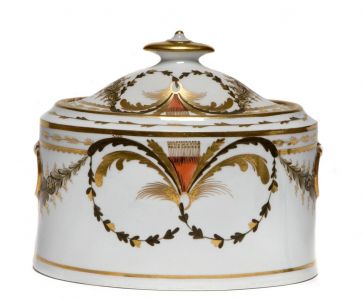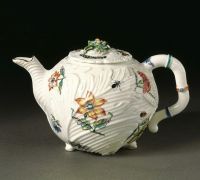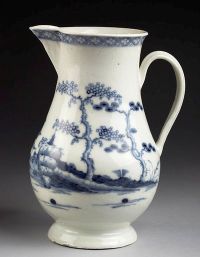- History
- Pottery
- Industry
Development of Bone China
|
English manufacturers had long sought the secrets of making porcelain. From the late 1740s to the 1760s, without access to the primary ingredients — china clay and china stone — English factories developed many different formulae that created a range of soft paste porcelains. Having discovered both of the necessary ingredients in Cornwall, in 1768 William Cookworthy took out a patent for the use of china clay and china stone in the manufacture of true or hard paste porcelain. Setting up first in Plymouth, by 1770 Cookworthy had moved production to Bristol. When, in 1773, Cookworthy retired he sold the patent rights to Richard Champion who extended the patent until 1796. By 1781, Champion, in financial difficulties, had sold the patent to a consortium of Staffordshire potters. When the patent expired in 1796, anyone could use china clay and china stone to make porcelain. Those conditions created a perfect storm of domestic English porcelain production. Spode rode this wave to financial success with their newest product: Bone China. For several years prior to the Cookworthy/Champion patent expiration, many manufacturers were attempting to develop a reliable recipe for a strong white porcelain. It seems likely that Josiah Spode I was experimenting with bone ash as an ingredient before his sudden death in 1797. A year earlier, in 1796, Spode I had invoiced William Tatton for “Queensware” and “English China.” Perhaps he had begun to discover a workable formula. On Spode II’s return to the Staffordshire pottery he continued his father’s work, by 1800 he was marketing bone china. Early examples of Spode’s bone china may carry the impressed mark “Stoke China,” identifying it definitively as Staffordshire porcelain. The formula Spode II used with such success was based on 25% each of china clay and china stone with 50% calcined bone. The phosphatic properties of the bone ash added warmth to the glassy grey-white body of hard paste porcelain. Notes in the Spode archives confirm that they investigating the properties of bone ash quite closely, “The best that can be used are the leg bones of oxen and cows but on no account horses bones as they are open and spongey [sic] whereas the former are solid…” |
 Spode bone china old oval shaped sugar, with enamel and gilt painted decoration, 1805-10 The Potteries Museum & Art Gallery, Stoke-on-Trent Click to watch a video of Robert Copeland discussing Spode and Bone China |





